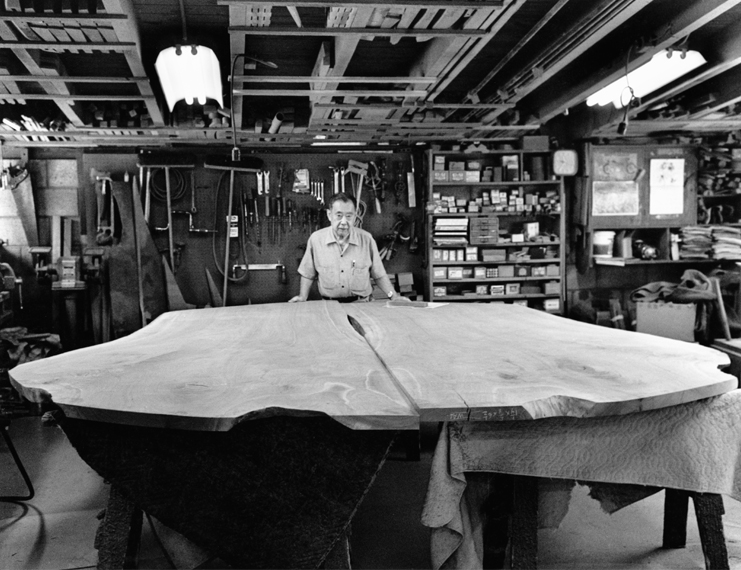
George Nakashima was a Japanese-American master woodworker, architect, and furniture maker who is revered as one of the great innovators of the 20th century in furniture design. He received his Bachelor’s Degree in Architecture from the University of Washington in Seattle in 1929, and from there he went on to earn his Master’s degree in Architecture from MIT in 1931. Upon completing his studies, Nakashima traveled the world, spending most of his time in Paris before accepting a job working for Japanese Architect, Antonin Raymond, who was best known for his collaboration on with Frank Lloyd Wright on the Imperial Hotel in Tokyo. It was at this time that his design philosophy began to emerge as he now believed that his work was an ‘expression of spirituality and beauty.’ (nakashimawoodworker.com)
Influences
Nakashima has an eclectic mix of influences that contribute to the uniqueness of his work. Growing up in the Pacific Northwest exposed him to a variety of exotic woods and gave him a deep appreciation for trees. His access to people who considered carpentry to be a ‘noble art form’ also impacted his relationship to natural materials. He was also greatly influenced by Japanese culture, carpentry, and design that he got a taste of firsthand during his time working and living there. (nakashimawoodworker.com)

Nakashima’s work has been referred to as ‘organic expressiveness’ and takes its roots in both modern and traditional design aesthetics. He was influenced by the design principles of Le Corbusier and Mies van der Rohe of the International Style, and the modernist movement of the 1920s and 1930s. His creations seem to effortlessly blend the two styles of Japanese traditionalism and organic modernism that give his furniture a style all of their own. Much of his Japanese influence stemmed from the Mingei movement, which relied heavily on the use of Japanese joinery techniques and natural materials.
Design Philosophy & Aesthetic
Nakashima referred to himself as a ‘Japanese Shaker’ which had to do with his belief that his designs should be treated as everyday functional objects and not ‘precious possessions’ (dwr.com). He had a profound respect for trees and sought to capture their noble character through his work. Through his spirituality, he felt that his work evoke the ‘soul of a tree.’
Finding beauty in imperfection, Nakashima intentionally sought out wood with flaws and was most attracted to Walnut, Cherry, and Ash wood for his furniture designs. He had a ‘gifted sense of grain, texture, and balance and only produced work of the highest quality of craftsmanship.

His signature style focused on natural forms and organic materials that predominantly included large wood slabs with smoothed tops and unfinished natural edges or multiple slabs connected with butterfly joints. His pieces tend to show off the natural grains and contours of the wood, and he never steered away from choosing woods with obvious burls or knots. He had a disdain for industrial materials and methods, opting instead to utilize a ‘personal craft based approach for design’ (Wikipedia.org) The vast majority of his work was custom built but he also allowed a select few large scale manufacturers, like Knoll company to produce ‘carefully supervised’ editions of his designs.

Major Works & Accolades
Nakashima began to commission his work in the mid-1940s. In the early years of the 1950s through the height of his career in the 1960s, Nakashima crafted his style based on the study of natural forms and materials. He enjoyed widespread success and held a prominent position within the American Arts and Crafts Movement at this time. He focused predominantly on the use of large-scale slabs of wood that had smooth surfaces and raw natural edges.

During his extensive career, his single most important commission came from the then governor of New York, Nelson A. Rockefeller who had Nakashima’s workshop design 200 pieces of furniture for his New York estate. He also designed interiors for Columbia University and in 1983, he accepted the order of the Sacred Treasure, an honor bestowed by the emperor of Japan. In 1986 his longtime dream was realized when he was commissioned to design the ‘Altar for Peace’ for the Cathedral of Saint John in Manhattan.
Legacy
Today Nakashima’s work is synonymous with the best of the 20th century American Art furniture and is represented in some of the most important collections of 20th-century design around the world including the New York Metropolitan Museum, and at auction can fetch upwards of $100,000 to $150,000 for a single piece of furniture.

“To be intimate with nature in its multifaceted moods is one of the greatest experiences of life.”
-George Nakashima
